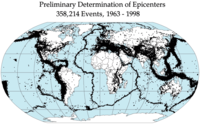
Photo from wikipedia
Using borehole strainmeters, we detected a 13‐day long slow slip event in 2011 with Mw = 5.45 on the Longitudinal Valley Fault, Taiwan. It has been likely promoted by the… Click to show full abstract
Using borehole strainmeters, we detected a 13‐day long slow slip event in 2011 with Mw = 5.45 on the Longitudinal Valley Fault, Taiwan. It has been likely promoted by the significant Coulomb stress changes (∼0.5–1 MPa) imparted by a combination of coseismic and postseismic slip of the 2003 Chengkung earthquake. Using kinematic slip models, we infer that the slow event has accommodated about 15%–35% of the slip deficit accumulated from 1997 to 2011 in its source region. Further, we find that inherited state of stress may have controlled the slow event southward propagation. We also highlight a spatiotemporal correlation between the slow event and a cluster of repeating microearthquakes, suggesting a complex interplay between seismic and aseismic processes on the fault, where transient aseismic regions are adjacent to highly coupled zones.
Journal Title: Geophysical Research Letters
Year Published: 2021
Link to full text (if available)
Share on Social Media: Sign Up to like & get
recommendations!